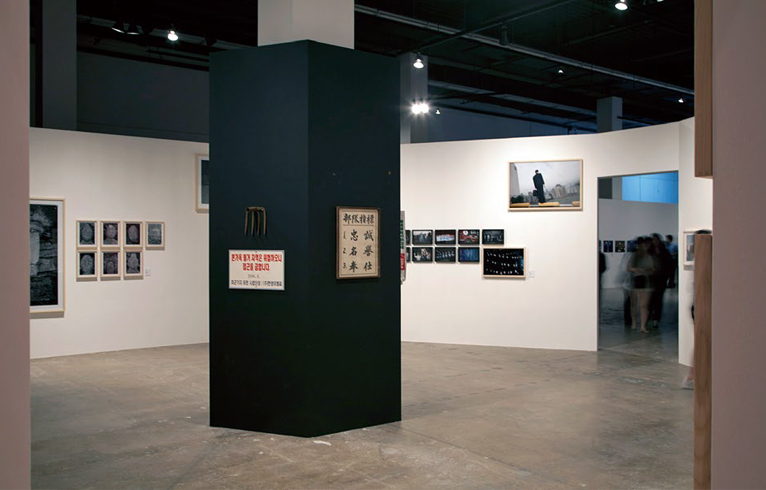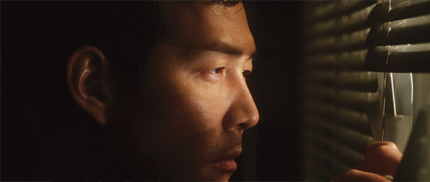GWANGJU BIENNALE 2012 : ROUNDTABLE
| March 15, 2013 | Post In LEAP 18

Media attention to this year’s Gwangju Biennale has for the most part been directed at its curatorial team, made up of six female curators from Mumbai, Qatar, Tokyo, Seoul, Beijing, and Jakarta respectively. The cities and countries in which these curators live and work roughly cover the most active economic regions, as well as the major communities, of East Asia, while the “female” and “community” taglines score several points for political correctness— albeit the kind of points that never fail to arouse a particular boredom in the audience.
The “Round Table” theme was adopted in response to the curatorial team’s utopian desire that “everyone sit together.” Unfortunately, the conditions engendered by this desire suffocated other, originally far richer and more exciting differences and conflicts, rendering them incapable of fully performing or expressing them-selves. This in another sense this re-confirms that recent collectivist trends are only possible within small-scale, spontaneous praxes and experiments. The required symbiotic relation-ships are scantly obtainable within more complex or large-scale mechanisms such as biennials, which are essentially always led by the tone of a sole curatorial voice; we generally remember a biennial by the stamp of the chief curator, not of her curatorial team.

Curator Wassan Al-Khudhairi’s section “Revisiting History” was readily comparable with curator Nancy Adajania’s “Logging In and Out of Collectivity,” but the fact that Adajania did not exert greater effort to engage with and reflect the rich history and contemporary conditions of Gwangju and Korea was surprising. In this dimly-lit space, we instead witness again a distinctly Middle Eastern view of Eurocentricity, one that has in recent years been consumed several times over. In contrast, Indonesian curator Alia Swastika’s “Impact of Mobility on Space and Time” massaged a burdensome, Asian-style democratic imagination with the playful gaiety of global consumerism. Japanese curator Mami Kataoka, her section titled “Transient Encounters,” mostly went for works by high-profile artists, adding greater visual and sculptural elements to the exhibition, while the majority of contributions from South Korean artists, including a section dedicated to young artists from the city of Gwangju, were located within Seoul curator Kim Sunjung’s hall of “Intimacy, Autonomy and Anonymity.” Chinese curator Carol Yinghua Lu was responsible for “Back to the Individual Experience,” this theme and its corresponding works displaying a faint connection to, and continuation of, the recently concluded 7th Shenzhen Sculpture Biennale, which she also co-curated. As the preface to each curatorial section was autographed by its respective author, a backwards trip around the Biennale became something of a guessing game of who chose what. Needless to say, this merriment succeeded in diverting attention away from the works themselves. All things considered, the themes chosen did not quite make leaps and bounds in flight of the major concerns of current global contemporary art theory and practice; instead, they stood proudly together, touting their respective colors, though their chorus of cries in this case was disappointingly disharmonious.
Knowledge of the Gwangju Biennale internationally is inextricably bound to the Gwangju Uprising of May 1980, a event now not only significant to Korean history, but also to the process and mode of democratization in Asia. To any young democratic nation, responding to such fresh national wounds is challenging. In the year 2000, Korean artist Noh Suntag set to work on Forgetting Machines I, re-photographing images of victims of the Gwangju Massacre that accompany the mass grave located in the old cemetery in the city. The original photographs have gradually eroded over the years, the heroes of the uprising becoming photographic relics. In this piece, Noh reminds us that when commemoration comes to rely upon a physical medium, it has perhaps already been drained of its genuine content and history. Forgetting Machines is also perhaps the sole work in the Biennale that enacts a direct response to the history of its host city. The works on display in Cinema Gwangju, Daein Market, and the other external exhibition sites— which ought to have been conducive to livelier and more vivid displays of local history— seemed to fall short somewhat, even sinking into frivolous and dispensable conceptualized, decorative tidbits.
In recent years, many biennials have featured artworks authored by “non-artists.” Pairing these with “real” artworks often brings about a fresh intertextuality, expanding our notions of the creation and subjectivity of art. One such work here left a lasting impression, a film by Chinese cinematographer and director Lü Yue titled The Obscure. Lü’s best known work is his directorial debut Mr. Zhao, which was banned for eight years; The Obscure is his second work. It combines two storylines: one documentary in nature, in which the director invited 11 prominent poets and writers to a hotel to take part in a symposium about the nature of poetry; and a second, fictional storyline which unfolds simultaneously and is centered around the chance meeting between a young waitress working at the symposium and her ex-boyfriend (both played by professional actors). The film concludes with the poets being asked if they think the pair could spend a final night together. The writers and poets are not actors; within the narrative, Lü ingeniously interweaves the two-fold intent and suppositions of both he himself as director and the writers. Other works of double or even multilayered narrative were on display in the same space: a commentary on early Chinese painting by American art historian James Cahill and Boris Groys’ “After History: Alexandre Kojève as a Photographer,” which offer considerably diverse footnotes to the “Back to the Individual Experience” theme.
While seeing the Biennale, I also unintentionally witnessed the judgment process of the Gwangju Biennale Noon Award, the panel of which was presided over by Gwangju’s previous curator, Massimiliano Gioni. The Established Artist Award was given to the duo of Moon Kyungwon and Jeon Joonho for their first collaboration, a film titled El Fin Del Mundo, which was shown earlier this year at dOCUMENTA (13) in Kassel. Indeed, even after a thousand years, images of the apocalypse still possess the aesthetic wonder to transcend cultural and national boundaries; the judges meanwhile declared that the film possesses the level of sophistication worthy of entering a permanent museum collection. A film starring two famous Korean actors also attracted a great amount of attention from local audiences. The evaluative criteria of these kinds of awards reconfirm the severe contradictions between globalization and native identity that skulk beneath the great majority of biennials. Few curatorial mechanisms, no matter how hard they try, will be able to escape the restrictions these contradictions predetermine. But when all is said and done, such exhibitions simply present a juncture within these incessant conflicts and contradictions at which things can sit side-by-side. Nikita Yingqian Cai (Translated by Dominik Salter Dvorak)

